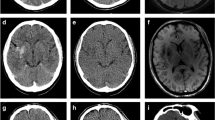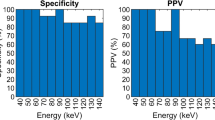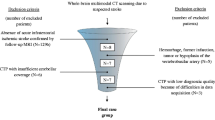Abstract
Objective
With the advancement of reperfusion therapy in stroke patients, assessment of perfusion status after therapy is gaining importance. Hyperperfusion tends to be underestimated by the conventional early imaging of 123I-IMP brain perfusion SPECT. We evaluated the utility of super-early imaging as an adjunct to early imaging for the assessment of postischemic hyperperfusion in stroke patients.
Methods
Sixty-seven patients who underwent 123I-IMP brain perfusion SPECT within 14 days after the onset of cerebral infarction were retrospectively analyzed. Super-early (4–10 min) and early (15–45 min) images were acquired using a dual-headed gamma camera. Postischemic hyperperfusion was visually assessed using the early images alone and then using both the super-early and early images, and the frequency of postischemic hyperperfusion and the confidence level of the judgement were evaluated. For quantitative evaluation of image contrast, the contrast ratios (the count ratios of the hyperperfused to normal areas) were calculated.
Results
The frequency of postischemic hyperperfusion was significantly higher using both the super-early and early images (28/67 patients) than using the early images alone (17/67 patients, p < 0.001). In 56 patients in whom judgement regarding the presence or absence of postischemic hyperperfusion was unchanged, the confidence level was increased in 8 patients using both image sets. The addition of the super-early SPECT images was judged to be useful and marginally useful in 14 and 15 patients, respectively. The contrast ratio was significantly higher on the super-early images (1.48 ± 0.25) than on the early images (1.26 ± 0.18, p < 0.001).
Conclusions
The addition of super-early imaging to the conventional early imaging aids assessment of postischemic hyperperfusion by 123I-IMP brain perfusion SPECT and may contribute to management of stroke patients in the era of reperfusion therapy.



Similar content being viewed by others
References
Powers WJ, Rabinstein AA, Ackerson T, Adeoye OM, Bambakidis NC, Becker K, et al. A guideline for healthcare professionals From the American Heart Association/American Stroke Association. Stroke. 2018;49:e46–110.
Soares BP, Chien JD, Wintermark M. MR and CT monitoring of recanalization, reperfusion, and penumbra salvage: everything that recanalizes does not necessarily reperfuse! Stroke. 2009;40:24–7.
De Silva DA, Fink JN, Christensen S, Ebinger M, Bladin C, Levi CR, et al. Assessing reperfusion and recanalization as markers of clinical outcomes after intravenous thrombolysis in the echoplanar imaging thrombolytic evaluation trial (EPITHET). Stroke. 2009;40:2872–4.
Abumiya T, Katoh M, Moriwaki T, Yoshino M, Aoki T, Imamura H, et al. Utility of early post-treatment single-photon emission computed tomography imaging to predict outcome in stroke patients treated with intravenous tissue plasminogen activator. Stroke Cerebrovasc Dis. 2014;23:896–901.
Okazaki S, Yamagami H, Yoshimoto T, Morita Y, Yamamoto H, Toyoda K, et al. Cerebral hyperperfusion on arterial spin labeling MRI after reperfusion therapy is related to hemorrhagic transformation. J Cereb Blood Flow Metab. 2017;37:3087–90.
Yu S, Liebeskind DS, Dua S, Wilhalme H, Elashoff D, Qiao XJ, et al. Postischemic hyperperfusion on arterial spin labeled perfusion MRI is linked to hemorrhagic transformation in stroke. J Cereb Blood Flow Metab. 2015;35:630–7.
Matsuda H, Li YM, Higashi S, Sumiya H, Tsuji S, Kinuya K, et al. Comparative SPECT study of stroke using Tc-99m ECD, I-123 IMP, and Tc-99m HMPAO. Clin Nucl Med. 1993;18:754–8.
Tsuchida T, Nishizawa S, Yonekura Y, Sadato N, Iwasaki Y, Fujita T, et al. SPECT images of technetium-99m-ethyl cysteinate dimer in cerebrovascular diseases: comparison with other cerebral perfusion tracers and PET. J Nucl Med. 1994;35:27–31.
Yonekura Y, Fujita T, Nishizawa S, Iwasaki Y, Mukai T, Konishi J. Temporal changes in accumulation of N-isopropyl-p-iodoamphetamine in human brain: relation to lung clearance. J Nucl Med. 1989;30:1977–81.
Lassen NA, Henriksen L, Holm S, Barry DI, Paulson OB, Vorstrup S, et al. Cerebral blood-flow tomography: xenon-133 compared with isopropyl-amphetamine-iodine-123: concise communication. J Nucl Med. 1983;24:17–21.
Nishizawa S, Tanada S, Yonekura Y, Fujita T, Mukai T, Saji H, et al. Regional dynamics of N-isopropyl-(123I)p-iodoamphetamine in human brain. J Nucl Med. 1989;30:150–6.
Takeshita G, Toyama H, Nakane K, Maeda H, Katada K, Takeuchi A, et al. Minor changes in regional cerebral blood flow revealed by the early distribution of I-123 IMP in brain. Radiat Med. 1991;9:196–201.
Yonekura Y, Nishizawa S, Mukai T, Iwasaki Y, Fukuyama H, Ishikawa M, et al. Functional mapping of flow and back-diffusion rate of N-isopropyl-p-iodoamphetamine in human brain. Nucl Med. 1993;34:839–44.
Namba H, Yanagisawa M, Yui N, Togawa T, Kinoshita F, Iwadate Y, et al. Quantifying brain tumor blood flow by the microsphere model with N-isopropyl-p-[123I]iodoamphetamine super-early SPECT. Ann Nucl Med. 1996;10:161–4.
Moretti JL, Defer G, Cinotti L, Cesaro P, Degos JD, Vigneron N, et al. “Luxury perfusion” with 99mTc-HMPAO and 123I-IMP SPECT imaging during the subacute phase of stroke. Eur J Nucl Med. 1990;16:17–22.
Crone C. The permeability of capillaries in various organs as determined by use of the ‘indicator diffusion’ method. Acta Physiol Scand. 1963;58:292–305.
Okamoto K, Ushijima Y, Okuyama C, Nakamura T, Nishimura T. Measurement of cerebral blood flow using graph plot analysis and I-123 iodoamphetamine. Clin Nucl Med. 2002;27:191–6.
Ichihara T, Ogawa K, Motomura N, Kubo A, Hashimoto S. Compton scatter compensation using the triple-energy window method for single- and dual-isotope SPECT. J Nucl Med. 1993;34:2216–21.
Sperling B, Lassen NA. Hyperfixation of HMPAO in subacute ischemic stroke leading to spuriously high estimates of cerebral blood flow by SPECT. Stroke. 1993;24:193–4.
Lassen NA, Sperling B. 99mTc-bicisate reliably images CBF in chronic brain diseases but fails to show reflow hyperemia in subacute stroke: report of a multicenter trial of 105 cases comparing 133Xe and 99mTc-bicisate (ECD, neurolite) measured by SPECT on same day. J Cereb Blood Flow Metab. 1994;14(Suppl 1):44–8.
Ogasawara K, Sakai N, Kuroiwa T, Hosoda K, Iihara K, Toyoda K, et al. Intracranial hemorrhage associated with cerebral hyperperfusion syndrome following carotid endarterectomy and carotid artery stenting: retrospective review of 4494 patients. J Neurosurg. 2007;107:1130–6.
Devous Sr MD, Thisted RA, Morgan GF, Leroy RF, Rowe CC. SPECT brain imaging in epilepsy: a meta-analysis. J Nucl Med. 1998;39:285–93.
Launes J, Sirén J, Valanne L, Salonen O, Nikkinen P, Seppäläinen AM, et al. Unilateral hyperfusion in brain-perfusion SPECT predicts poor prognosis in acute encephalitis. Neurology. 1997;48:1347–51.
Ito H, Mori K, Kagami S. Neuroimaging of stroke-like episodes in MELAS. Brain Dev. 2011;33:283–8.
Author information
Authors and Affiliations
Corresponding author
Ethics declarations
Conflict of interest
There is no conflict of interest in relation to this study.
Rights and permissions
About this article
Cite this article
Inoue, Y., Hara, T., Ikari, T. et al. Super-early images of brain perfusion SPECT using 123I-IMP for the assessment of hyperperfusion in stroke patients. Ann Nucl Med 32, 695–701 (2018). https://doi.org/10.1007/s12149-018-1293-5
Received:
Accepted:
Published:
Issue Date:
DOI: https://doi.org/10.1007/s12149-018-1293-5




